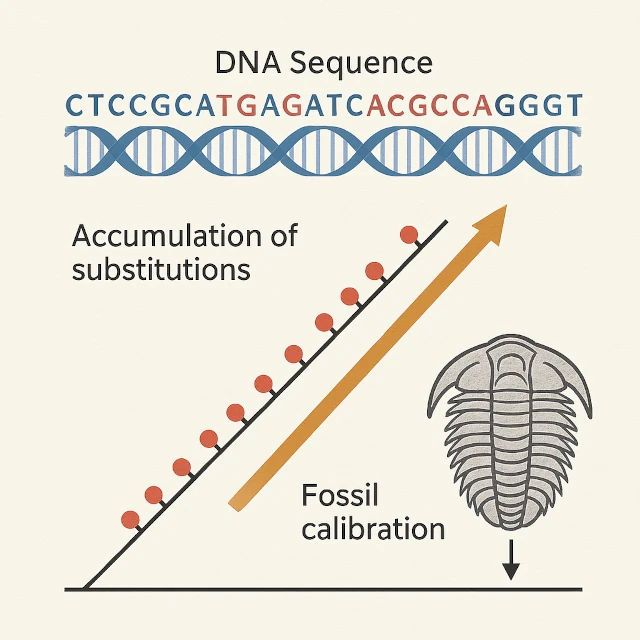
The molecular clock is a revolutionary concept in evolutionary biology that allows dating speciation events by using the rate of mutation accumulation in the genome.
The term "molecular clock" refers to the ability to estimate the time elapsed since the divergence of two lineages by measuring the amount of differences accumulated in their biomolecular sequences. The principle is based on the idea that neutral substitutions accumulate at an average rate, which can be used as a chronometer.
N.B.:
A neutral substitution is a change in the DNA or protein sequence that has no effect on the survival or reproduction of the organism. These substitutions are neither favored nor eliminated by natural selection and therefore accumulate randomly over time.
In its simplest form, the relationship between divergence and time is given by \(T = \dfrac{D}{2\mu}\).
| Symbol | Name | Unit | Physical meaning |
|---|---|---|---|
| \(T\) | Divergence time | years (or Ma) | Time elapsed since two lineages diverged from a common ancestor; this is the measure of time that the molecular clock allows to estimate. |
| \(D\) | Genetic distance | substitutions/site | Average proportion of differences accumulated between two homologous sequences since their separation; reflects the number of substitutions neutralized by independent evolution in each lineage. |
| \(\mu\) | Mutation rate | substitutions/site/year | Frequency at which a particular base is replaced by another over a unit of time in a lineage; this is the speed of the molecular clock. |
N.B.:
In evolutionary biology, a lineage refers to a set of organisms descending from one another through reproduction, forming a continuous chain over time. In the context of the molecular clock, each lineage independently accumulates substitutions, and the genetic distance \(D\) between two lineages corresponds to the sum of changes that have occurred in each since their last common ancestor.
The molecular clock has revolutionized our understanding of evolution by allowing precise dating of key events in the history of life, from divergences between major taxonomic groups to recent evolutionary events.
It has notably resolved long-standing debates on the chronology of evolution and provided temporal frameworks for phenomena as varied as the emergence of new species, human migrations, the origin of pandemics, and the domestication of species.
| Divergence event | Estimated time | Genetic material used | Reliability |
|---|---|---|---|
| Eukaryotes - Prokaryotes | 2-3 billion years | Ribosomal genes | Moderate |
| Origin of photosynthesis | 2.5-3.2 billion years | Photosynthetic genes | Moderate |
| Mammals - Birds | 310 million years | Conserved genes | Medium |
| Origin of flowering plants | 300 million years | Chloroplast genes | Medium |
| Radiation (rapid diversification) of dinosaurs | 230-250 million years | Skeletal genes | Moderate |
| Divergence birds - crocodilians | 240-275 million years | Nuclear genes | Medium |
| Radiation (rapid diversification) of placental mammals | 66-100 million years | Mitochondrial and nuclear DNA | Medium |
| Cetaceans - Hippopotamuses | 50-60 million years | Nuclear genes | High |
| Human - Chimpanzee | 6-8 million years | Nuclear and mitochondrial genome | High |
| Mouse - Rat | 12-24 million years | Complete genome | High |
| Neanderthal - Modern Human divergence | 550,000-765,000 years | Ancient nuclear genome | High |
| Domestication of the dog | 15,000-40,000 years | Mitochondrial DNA | Medium |
| Colonization of the Americas | 15,000-20,000 years | Complete human genome | High |
| Out of Africa migration of Homo sapiens | 60,000-100,000 years | Mitochondrial DNA and Y chromosome | High |
| Domestication of rice | 8,000-13,000 years | Chloroplast genome | High |
| Emergence of HIV-1 | Early 20th century | Complete viral genome | High |
| Emergence of SARS-CoV-2 | 2019 | Complete viral genome | High |
Additional sources and tools: PubMed / NCBI, BEAST (Bayesian clocks), Scientific literature.
Despite its power, the molecular clock has several important limitations:
Source: Nature - The molecular clock and evolutionary relationships and Science - Molecular Clocks in Evolution.